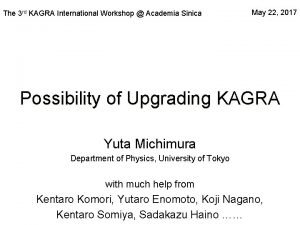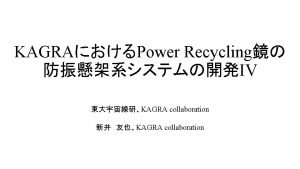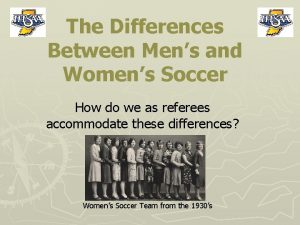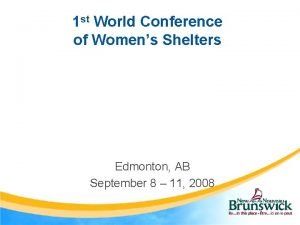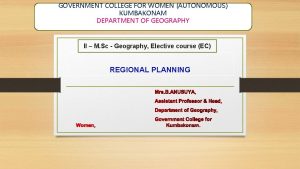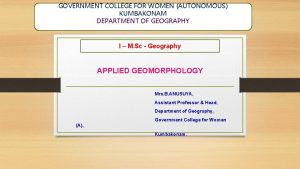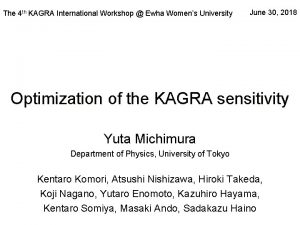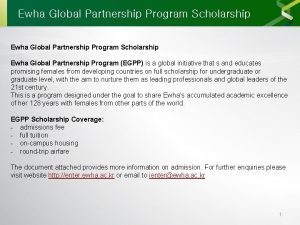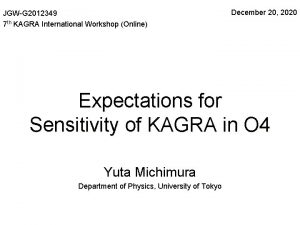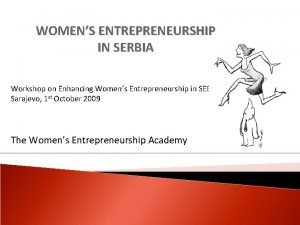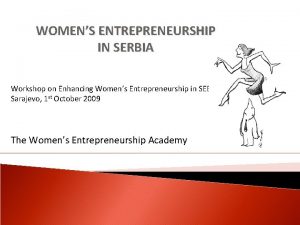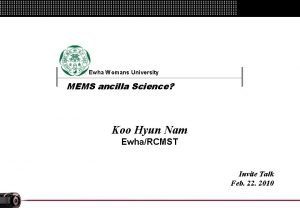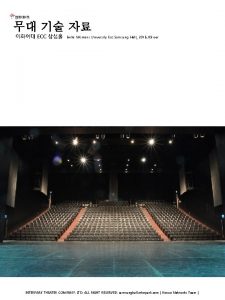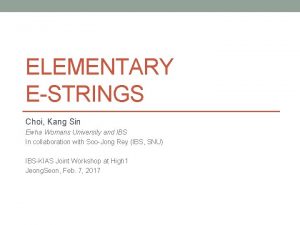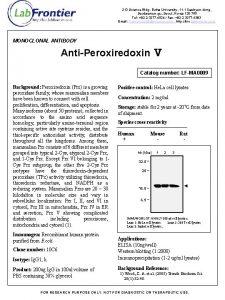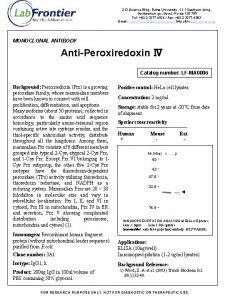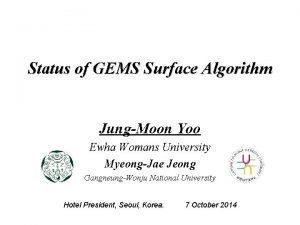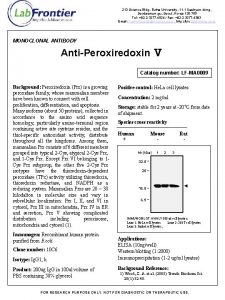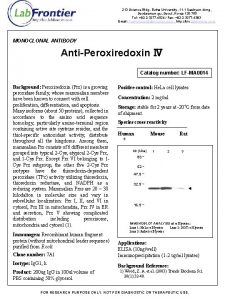The 4 th KAGRA International Workshop Ewha Womens





















































- Slides: 53

The 4 th KAGRA International Workshop @ Ewha Women’s University June 30, 2018 Optimization of the KAGRA sensitivity Yuta Michimura Department of Physics, University of Tokyo Kentaro Komori, Atsushi Nishizawa, Hiroki Takeda, Koji Nagano, Yutaro Enomoto, Kazuhiro Hayama, Kentaro Somiya, Masaki Ando, Sadakazu Haino

Overview • Developed a new way to optimize the KAGRA sensitivity design based on - CBC inspiral range - CBC parameter estimation • Optimization done by Particle Swarm Optimizer YM+, Phys. Rev. D 97, 122003 (2018) • Studied possible KAGRA+ candidates with budget constraints - 40 kg mirror with better coating - 400 W laser with squeezing - Frequency dependent squeezing 2

Room Temperature Design • Seismic noise: reduce as much as possible multi-stage suspensions underground • Thermal noise: reduce as much as possible larger mirror thinner and longer wires • Quantum noise: optimize the shape input laser power tune signal recycling parameters 3

Cryogenic Design is Complicated • Seismic noise: reduce as much as possible multi-stage suspensions heat underground extraction • Thermal noise: reduce as much as possible larger mirror thinner and longer wires cryogenic cooling • Quantum noise: optimize the shape input laser power tune signal recycling parameters 4

Cryogenic Design is Complicated • Seismic noise: reduce as much as possible multi-stage suspensions heat underground extraction • Thermal noise: reduce as much as possible optimize larger mirror thinner and longer wires cryogenic cooling worse cooling power mirror heating • Quantum noise: optimize the shape input laser power tune signal recycling parameters 5

Grid-based Search is not Scalable • Future GW detectors (like KAGRA+) require more parameters to be optimized • Almost impossible with grid-based approach Parameter B • Sensitivity design is an optimization problem • Grid-based parameter search - deterministic - computational cost grows exponentially with number of parameters Parameter A 6

Particle Swarm Optimization! • Particles search the parameter space based on own best position and entire swarm’s best known position global best personal best position so far inertia coefficient w=0. 72 acceleration coefficient c=1. 19 random number r ∈ [0, 1] Parameter space Kennedy & Eberhart (1995) 7 values for w and c are from Standard PSO 2006

Apply PSO for KAGRA Design • RSE interferometer • Cryogenic sapphire test masses 16 K sapphire fibers Laser ~20 K suspension thermal noise with non-uniform temperature K. Komori+ PRD 97 102001 (2018) 8

Parameters of Interest • 7 parameters are relatively easy to be retuned • Search range based on feasibility input power to BS fiber length and diameter Laser SRC detuning angle homodyne angle SRM reflectivity mirror temperature 9

3 Parameter Optimization • Consistent with grid-based approach 10

3 Parameter Optimization • Consistent with current designed sensitivity which was optimized with grid-based approach 11

3 Parameter Optimization • Consistent with current designed sensitivity which was optimized with grid-based approach n sio en sp su mic seis mirr or quantum 12

7 Parameter Optimization • Changing suspension fibers and SRM increases BNS IR from 153 Mpc to 169 Mpc (10% increase) 13

7 Parameter Optimization • Changing suspension fibers and SRM increases BNS IR from 153 Mpc to 169 Mpc (10% increase) n sio en sp su mic seis mirr or shorter and thicker to put more power with 20 K (min) quantum 14

Sky Localization Optimization • Cost function: sky localization of GW 170817 -like binary - 1. 25 -1. 5 Msun at 40 Mpc, inclination 28 deg - zero spins, no precession - 108 sets of sky location and polarization angle KAGRA to derive median of sky localization error Ad. V PSO • Fisher matrix to estimate the error - inspiral waveform to 3. 0 PN in amplitude 3. 5 PN in phase - 11 binary parameters • HLVK global network a. LIGO 15

3 Parameter Optimization • Sky localization improved by a factor of 1. 3 2 0. 18 deg but inspiral range is reduced by 20% → 0. 14 deg 2 2600 W at BS 30 K sio en sp su mic seis mirr n or quantum 16

7 Parameter Optimization • Sky localization improved by a factor of 1. 6 2 0. 18 deg but inspiral range is reduced by 2% → 0. 11 deg 2 n or io mirr s en sp su mic seis shortest and thickest fibers 12 k. W at BS 27 K quantum 17

KAGRA+ with Budget Constraints • Let’s consider a bit more drastic upgrades • Suppose you have $5 M for KAGRA+ • Candidates would be A. 40 kg mirror with better coating (>$4 M? ) and new sapphire fibers ($1 M? ) (use existing cryostat and Type-A tower) B. 400 W laser ($3 M? ) with squeezing ($1 M? ) and new sapphire fibers ($1 M? ) C. Frequency dependent squeezing ($3 M? ) and new sapphire fibers ($1 M? ) 18

Plan A: 40 kg Mirror • Also assumes factor of 2 coating loss angle reduction (no beam size change assumed) n mirr io s en mic sp su seis Good for mid frequency improvement → BNS range optimized or T=20. 1 K 181 W input quantum thicker fiber 25. 0 cm φ1. 2 mm (thicker to allow for higher power) 19

Plan B: 400 W Laser with SQZ • Assumes 10 d. B input SQZ or n mirr io s en sp su mic seis Good for high frequency improvement → BNS range optimized T=29. 8 K 330 W input shorter and thicker fiber 20. 1 cm quantum φ1. 2 mm (high power with high 20 temperature)

Plan C: Freq. Dependent SQZ • Assumes 10 d. B input SQZ and 100 m filter cavity Broadband improvement → BNS range optimized n sio en sp su mic seis mirr or T=21. 8 K 85 W input thinner fiber 26. 1 cm φ0. 8 mm quantum (SQZ helps to ease fiber requirement) 21

Summary of $5 M Plans • A. New mirror takes time to fabricate • B. High power operation is tough • C. Does it fit in the facility? Inspiral range (Mpc) b. KAGRA A. 40 kg mirror B. 400 W laser C. Freq. dep. SQZ BBH 100 BBH 30 BNS 353 339 117 470 1095 1096 311 1177 153 213 123 181 BNS localize (deg 2) 0. 183 0. 151 0. 114 0. 135 • I like A because of simplicity, but if fabrication of heavier mirrors cannot be done on time, go for C? 22

Summary • Demonstrated sensitivity design with PSO • Application to KAGRA shows both - BNS inspiral range - BNS sky localization can be improved by retuning 7 parameters of existing components YM+, Phys. Rev. D 97, 122003 (2018) • Also applied to KAGRA+ study and showed optimized sensitivity for 3 candidates - 40 kg mirror with better coating - 400 W laser with squeezing - frequency dependent squeezing 23

Supplementary Slides

Swarm size PSO Algorithm determined by probability of Initialize particle positions randomly convergence (10~200) Calculate KAGRA sensitivity Update particle positions Calculate cost function NO Change smaller than threshold? YES Terminate 25

PSO Algorithm Initialize particle positions randomly strain Calculate KAGRA sensitivity Update particle positions quantum ic seism the. NO rma l frequency Calculate cost function Change smaller than threshold? YES Terminate 26

PSO Algorithm strain Initialize particle positions randomly BNS inspiral range as a cost function Calculate KAGRA sensitivity quantum Update BNS coale Calculate cost function particle scence SNR positions ic seism the. NO rma l frequency Change smaller than threshold? YES Terminate 27

PSO Algorithm Initialize particle positions randomly BNS inspiral range as a cost function Calculate KAGRA sensitivity Update particle positions Calculate cost function Change smaller than threshold? Threshold: 0. 001 Mpc YES Terminate NO 28

PSO Algorithm Initialize particle positions randomly Calculate KAGRA sensitivity Update particle positions Calculate cost function NO Change smaller than threshold? YES Terminate 29

Pyswarm • Python package Pyswarm was used for this work https: //pythonhosted. org/pyswarm/ https: //github. com/tisimst/pyswarm/ • PSO as easy as xopt, fopt = pso(func, lb, ub) lower and upper optimal cost function bounds parameter cost set function 30

PSO for GW Related Research • CBC search Weerathunga & Mohanty, PRD 95, 124030 (2017) Wang & Mohanty, PRD 81, 063002 (2010) Bouffanais & Porter, PRD 93, 064020 (2016) • Continuous GW search using pulsar timing array Wang, Mohanty & Jenet, Ap. J 795, 96 (2014) • Cosmological parameter estimation using CMB Prasad & Souradeep, PRD 85, 123008 (2012) • Gravitational lens modeling Rogers & Fiege, Ap. J 727, 80 (2011) • Sensor correction filter design Conor Mow-Lowry, LIGO-G 1700841 LIGO-T 1700541 • Voyager quantum noise optimization 31 input power, arm finesse, SRM transmissivity, homodyne, filter cavity

Pros and Cons of PSO • Fast even for highly multidimensional parameter space uses entire swarm’s information to search • Requires small number of design variables and little prior information basically only swarm size and termination criterion prior information is only search range • No guarantee for convergence to global maximum stochastic method • Do not give error of the parameters no direct information on stability of the solution → Sounds great for detector design 32

Other Optimization Methods • Simulated annealing tuning cooling schedule is troublesome • Genetic algorithm too many design variables • Markov chain Monte Carlo tend to be dependent on prior distribution gives error from posterior distribution takes time • Machine learning if the problem well-modeled, you don’t need ML 33

Swarm Size Determination • Probability of convergence: ratio of PSO trials resulted within 0. 1 Mpc or 10 -3 deg 2 • Increased swarm size until probability of convergence is larger than 90% number of params 3 number of particles 10 number of iterations 52± 13 probability of convergence 98 % 5 20 73± 16 96 % 7 200 60± 18 91 % * From 100 PSO trials 34

Sensitivity Design with PSO is Fast • Optimization done in O(10) minutes with my laptop • Number of cost function evaluations 3 params 5 params 7 params Grid-based ~105 ~109 ~1014 PSO 10×(52± 13) 20×(73± 16) 200×(60± 18) * In case optimization is done at precision of 0. 1 Mpc • Computational cost do not grow exponentially with dimensionality of parameter space • Useful for optimization with many parameters, computationally expensive cost function 35

IFO Parameter Search Range Lower bound Upper bound KAGRA Default Precision 86. 5 (or 60) * 90 86. 5 0. 1 Homodyne angle [deg] 90 180 135. 1 3 Mirror temperature [K] 20 30 22 0. 09 Power attenuation 0. 01 1 1 0. 02 SRM reflectivity 0. 5 1 0. 92 (85%) 6 e-4 Wire length [cm] 20 100 35 0. 02 Wire safety factor 3 30 12. 57 (0. 8 mm) 0. 07 Detuning angle [deg] * Considering SRC nonlinearity, maximum detuning is 3. 5 deg (see Y. Aso+ CQG 29, 124008) • Reflecting wall boundary: x=xmax, v=-v if x>xmax x=xmin, v=-v if x<xmin step size which changes BNS inspiral range by 0. 1 Mpc 36

Money • Detuning angle and homodyne angle can be retuned without additional cost • Mirror temperature and input power can be retuned without additional cost if power at BS is less than ~1 k. W (~100 W entering PRM) • Change in SRM reflectivity require ~0. 1 Million USD • Change in wire parameters require ~0. 01 Million USD/fiber • Change in wire length additionally require test mass suspension design change at ~0. 1 Million USD/mirror • Change in the test mass require ~0. 6 Million USD/mirror (more for heavier ones) 37

Fiber Length and Diameter • 25 cm/φ1. 4 mm is optimum for BNS IR if other parameters are fixed (default: 35 cm/φ1. 6 mm) 38

Fisher Matrix Analysis • Fisher matrix • Covariance • 11 binary parameters considered mc: chirp mass eta: symmetric mass ratio tc, phic: time and phase for coalescence d. L: luminosity distance chis, chia: symmetric/asymmetric spin thetas, phis: colatitude / longitude of source cthetai: inclination angle psip: polarization angle 39

Optimization for Fixed Sky Location • Result for fixed sky location and polarization angle is similar to sky average optimization n or io mirr s en sp su mic seis shortest and thickest fibers 1. 7 k. W at BS 30 K (max) quantum 40

Symmetric Spin Optimization • Similar to sky localization optimization (focus on high frequencies) n or io mirr s en sp su mic seis shortest and thickest fibers 1. 7 k. W at BS 30 K (max) quantum 41

Asymmetric Spin Optimization • Similar to sky localization optimization (focus on high frequencies) n or io mirr s en sp su mic seis shortest and thickest fibers 1. 7 k. W at BS 30 K (max) quantum 42

Distance Optimization • Similar to inspiral range optimization, but slight shift to high frequencies (slight improvement by 2%) n sio en sp su mic seis shorter and thicker fibers 2. 3 k. W at BS 24 K mirr or quantum 43

Inclination Angle Optimization • Similar to distance optimization (PE degeneracy) n sio en sp su mic seis shorter and thicker fibers 2. 3 k. W at BS 24 K mirr or quantum 44

BBH 100 IR Optimization • Low power, low temperature with thin and longer fibers (KAGRA+ LF concept) x 4 heavier IM seis with thinner IM suspension Less ambient heat Allowed higher detuning mirr sio en sp su mic quantum or n 45

Sky Localization with HLV No KAGRA HLVK+ median 0. 472 deg 2 46

Sky Localization with HLVK Default KAGRA HLVK+ median 0. 472 deg 2 0. 168 deg 2 47

Sky Localization with HLVK+ PSO KAGRA HLVK+ median 0. 472 deg 2 0. 168 deg 2 0. 107 deg 2 48

Antenna Pattern 49

2 G/2 G+ Parameter Comparison KAGRA Ad. Virgo a. LIGO A+ Voyager Arm length [km] 3 3 4 4 4 Mirror mass [kg] 23 42 40 80 200 Mirror material Sapphire Silica Silicon Mirror temp [K] 22 295 295 123 Sus fiber 35 cm Sap. 70 cm Si. O 2 60 cm Si Fiber type Fiber Ribbon Input power [W] 67 125 125 140 Arm power [k. W] 340 700 710 1150 3000 Wavelength [nm] 1064 2000 3. 5 / 3. 5 4. 9 / 5. 8 5. 5 / 6. 2 5. 8 / 6. 2 0 0 0 6 8 none 16 300 Beam size [cm] SQZ factor F. C. length [m] LIGO parameters from LIGO-T 1600119, Ad. Virgo parameters from JPCS 610, 01201 (2015) 50

KAGRA Detailed Parameters • • • K. Komori et al. , JGW-T 1707038 Optical parameters - Mirror transmission: 0. 4 % for ITM, 10 % for PRM, 15. 36 % for SRM - Power at BS: 674 W - Detune phase: 3. 5 deg (DRSE case) - Homodyne phase: 135. 1 deg (DRSE case) Sapphire mirror parameters - TM size: 220 mm dia. , 150 mm thick - TM mass: 22. 8 kg - TM temperature: 22 K - Beam radius at ITM: 3. 5 cm - Beam radius at ETM: 3. 5 cm - Q of mirror substrate: 1 e 8 - Coating: tantala/silica - Coating loss angle: 3 e-4 for silica, 5 e-4 for tantala - Number of layers: 22 for ITM, 40 for ETM - Coating absorption: 0. 5 ppm - Substrate absorption: 50 ppm/cm Suspension parameters - TM-IM fiber: 35 cm long, 1. 6 mm dia. - IM temperature: 16 K - Heat extraction: 5800 W/m/K at 20 K - Loss angle: 5 e-6/2 e-7/7 e-7 for Cu. Be fiber/sapphire blade Inspiral range calculation - SNR=8, fmin=10 Hz, sky average constant 0. 442478 Seismic noise curve includes vertical coupling, vibration from 51 heatlinks and Newtonian noise from surface and bulk

KAGRA Cryopayload Provided by T. Ushiba and T. Miyamoto 3 Cu. Be blade springs Platform (SUS, 65 kg) Marionette (SUS, 22. 5 kg) Intermediate Mass (SUS, 20. 1 kg, 16 K) Test Mass (Sapphire, 23 kg, 22 K) MN suspended by 1 Maraging steel fiber (35 cm long, 2 -7 mm dia. ) MRM suspended by 3 Cu. Be fibers Heat link attached to MN IM suspended by 4 Cu. Be fibers (24 cm long, 0. 6 mm dia) IRM suspended by 4 Cu. Be fibers 4 sapphire blades TM suspended by 4 sapphire fibers (35 cm long, 1. 6 mm dia. ) RM suspended by 4 Cu. Be fibers 52

KAGRA Cryostat Schematic ar. Xiv: 1710. 04823 53
 Kagra international workshop
Kagra international workshop Kagra
Kagra Womens right
Womens right Mens lacrosse helmet
Mens lacrosse helmet Womens right
Womens right Womens rights
Womens rights Womens community shelters
Womens community shelters Womens history month door
Womens history month door Differences between men's and women's soccer
Differences between men's and women's soccer Bristol womens voice
Bristol womens voice Womens shelter edmonton
Womens shelter edmonton Late night womens hour
Late night womens hour Ballybeen womens centre
Ballybeen womens centre Womens college kumbakonam
Womens college kumbakonam Women's rights
Women's rights Claire paine
Claire paine Scarborough womens centre
Scarborough womens centre Womens college kumbakonam
Womens college kumbakonam Womens ministry activities
Womens ministry activities Function of uterine cavity
Function of uterine cavity Glasgow thang điểm
Glasgow thang điểm ưu thế lai là gì
ưu thế lai là gì Tư thế ngồi viết
Tư thế ngồi viết Cái miệng xinh xinh thế chỉ nói điều hay thôi
Cái miệng xinh xinh thế chỉ nói điều hay thôi Các châu lục và đại dương trên thế giới
Các châu lục và đại dương trên thế giới Mật thư anh em như thể tay chân
Mật thư anh em như thể tay chân Bổ thể
Bổ thể Tư thế ngồi viết
Tư thế ngồi viết V cc cc
V cc cc Thẻ vin
Thẻ vin Thơ thất ngôn tứ tuyệt đường luật
Thơ thất ngôn tứ tuyệt đường luật Hát lên người ơi alleluia
Hát lên người ơi alleluia Hổ sinh sản vào mùa nào
Hổ sinh sản vào mùa nào Từ ngữ thể hiện lòng nhân hậu
Từ ngữ thể hiện lòng nhân hậu Diễn thế sinh thái là
Diễn thế sinh thái là Vẽ hình chiếu vuông góc của vật thể sau
Vẽ hình chiếu vuông góc của vật thể sau Phép trừ bù
Phép trừ bù Tỉ lệ cơ thể trẻ em
Tỉ lệ cơ thể trẻ em Lời thề hippocrates
Lời thề hippocrates Vẽ hình chiếu đứng bằng cạnh của vật thể
Vẽ hình chiếu đứng bằng cạnh của vật thể đại từ thay thế
đại từ thay thế Quá trình desamine hóa có thể tạo ra
Quá trình desamine hóa có thể tạo ra Các môn thể thao bắt đầu bằng tiếng nhảy
Các môn thể thao bắt đầu bằng tiếng nhảy Công thức tiính động năng
Công thức tiính động năng Hình ảnh bộ gõ cơ thể búng tay
Hình ảnh bộ gõ cơ thể búng tay Sự nuôi và dạy con của hổ
Sự nuôi và dạy con của hổ Thế nào là mạng điện lắp đặt kiểu nổi
Thế nào là mạng điện lắp đặt kiểu nổi Dot
Dot Thế nào là sự mỏi cơ
Thế nào là sự mỏi cơ độ dài liên kết
độ dài liên kết Voi kéo gỗ như thế nào
Voi kéo gỗ như thế nào Thiếu nhi thế giới liên hoan
Thiếu nhi thế giới liên hoan điện thế nghỉ
điện thế nghỉ Một số thể thơ truyền thống
Một số thể thơ truyền thống
